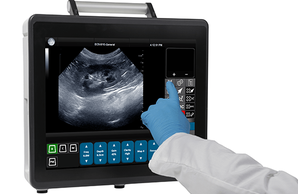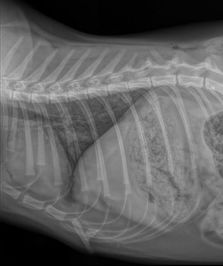Diagnostic Ultrasound

What is an ultrasound?
An ultrasound exam uses sound waves to produce images that show inside your pet's body. It's painless and noninvasive.
Saint Francis Animal Hospital has partnered with Oncura to provide our clients state-of-the-art ultrasound equipment. We use this painless and noninvasive method to examine internal organs and diagnose issues within the soft tissue organs. Our vets might perform an ultrasound for various reasons. Although it can be used for routine screening, an ultrasound is most commonly recommended after blood work or radiographs indicate a possible problem. Your veterinarian will use the ultrasound to evaluate your pet's organs, chest cavity or other bodily structures to obtain an accurate diagnosis. If necessary, we can send the images out to board-certified radiologists for additional interpretation and telemedicine consultations.
An ultrasound exam uses sound waves to produce images that show inside your pet's body. It's painless and noninvasive.
Saint Francis Animal Hospital has partnered with Oncura to provide our clients state-of-the-art ultrasound equipment. We use this painless and noninvasive method to examine internal organs and diagnose issues within the soft tissue organs. Our vets might perform an ultrasound for various reasons. Although it can be used for routine screening, an ultrasound is most commonly recommended after blood work or radiographs indicate a possible problem. Your veterinarian will use the ultrasound to evaluate your pet's organs, chest cavity or other bodily structures to obtain an accurate diagnosis. If necessary, we can send the images out to board-certified radiologists for additional interpretation and telemedicine consultations.
In-House Digital X-RAYS

Radiography is a valuable diagnostic tool in veterinary medicine. As we continually strive to offer the highest quality medicine and diagnostic testing, we are pleased to offer digital radiology services as a means of providing excellent care to our patients.
A radiograph (sometimes called an x-ray) is a type of photograph that can look inside the body and reveal information that may not be discernable from the outside. Radiography can be used to evaluate almost any organ in the body, including the heart, lungs, and abdominal organs, as well as the bones. Radiography is painless, safe, and completely non-invasive, and it uses only very low doses of radiation. Because the level of radiation exposure needed to perform radiography is very low, even pregnant females and very young pets can undergo radiography.
Radiographs can be used to evaluate bones as well as the size, shape, and position of many of the body's organs. The size of organs is important because some medical conditions—such as kidney, heart, or liver disease—can alter the size of these organs. The shape and position of organs can be altered or distorted by certain medical conditions, including intestinal blockage , cancer or tumors depending on their size and location can also sometimes be detected using radiography. Radiography can also be used to diagnose bladder stones, broken bones, chronic arthritis, certain spinal cord diseases, and a variety of other conditions.
Radiographs are an important tool that can help us make a correct diagnosis for your pet. Offering digital radiographs allows us to do them in a quick amount of time usually while you wait in the exam room.
Our digital radiology service is staffed by caring, skilled professionals who will provide state-of-the-art care with compassion and expertise.
A radiograph (sometimes called an x-ray) is a type of photograph that can look inside the body and reveal information that may not be discernable from the outside. Radiography can be used to evaluate almost any organ in the body, including the heart, lungs, and abdominal organs, as well as the bones. Radiography is painless, safe, and completely non-invasive, and it uses only very low doses of radiation. Because the level of radiation exposure needed to perform radiography is very low, even pregnant females and very young pets can undergo radiography.
Radiographs can be used to evaluate bones as well as the size, shape, and position of many of the body's organs. The size of organs is important because some medical conditions—such as kidney, heart, or liver disease—can alter the size of these organs. The shape and position of organs can be altered or distorted by certain medical conditions, including intestinal blockage , cancer or tumors depending on their size and location can also sometimes be detected using radiography. Radiography can also be used to diagnose bladder stones, broken bones, chronic arthritis, certain spinal cord diseases, and a variety of other conditions.
Radiographs are an important tool that can help us make a correct diagnosis for your pet. Offering digital radiographs allows us to do them in a quick amount of time usually while you wait in the exam room.
Our digital radiology service is staffed by caring, skilled professionals who will provide state-of-the-art care with compassion and expertise.